Green River, Running Red Read online
Page 2
And now Wendy’s sad little life was over before it really began. Her blurry photo appeared over and over in the media as the story of her murder was updated and details added. She was an attractive blond-haired girl, and I had written about hundreds of homicide cases in the dozen years before Wendy was killed, a number of them about pretty blondes who had been strangled.
But she was so young, and I learned she had been violently choked with her own panties. I had teenagers myself, and I remembered the girls I’d known when I was in college and worked summers as a student intern at Hillcrest, the juvenile girls’ training center in Salem, Oregon (a facility once known as a reform school). The Hillcrest residents ranged in age from thirteen to eighteen, and they tried to act tough, although I soon realized just how frightened and vulnerable most of them were.
Maybe that’s why I saved the clipping about the girl in the Green River. Or maybe it was because Wendy’s body had been found close to where I lived in the south end of King County, Washington. At least a thousand times over the forty years I’ve lived here, I’ve passed the very spot where someone threw her away.
To reach this stretch of the Green River from my house, I had to cross Highway 99 and head about four miles down the long curving hill that is the Kent–Des Moines Road. The Green River coursed south from Eliott Bay and the Duwamish Waterway, irrigating the floor of the Kent Valley. In the days before the Boeing Airplane Company expanded and the Southcenter Mall mushroomed, the valley was known for its rich loamy soil and was home to family farms, many of which supplied produce to Seattle’s Public Market, or who simply put up their own stands along the road. When my children were small, I took them every summer to one of the U-Pick strawberry patches that abounded in the valley. We often took Sunday drives through Kent, Auburn, and Puyallup.
I had also driven along Frager Road on the Green River’s western bank in almost total darkness any number of nights, coming home from dinner with friends or from shopping at the Southcenter Mall. The lights of the huge mall faded within minutes as the road became indistinguishable from the river.
North of the Meeker Street Bridge, Frager Road and the rushing river frightened me a little at night because there were hardly any houses nearby, and winter rains made the Green River run so deep that it nudged the shoulders of the road. Drivers under the influence or inexperienced or reckless often missed turns on the narrow road and sailed into the river. Few of them survived. Sometimes they floated in the depths for a long time, because nobody was aware that their cars and bodies waited there beneath the surface.
In the moonless dark, the lonely road along the river seemed somehow sinister, although I could never come up with a good reason why I felt that way. It was just a river in the daytime, running past fields, tumbling-down farmhouses, and one tiny park that had two rickety picnic tables. There were usually a few dozen fishermen huddled in little lean-tos made of scrap wood, angling for steelheads along the river.
Despite my foreboding, I often took Frager Road home after midnight because it was a shortcut to my house on S. 244th Street. When I came to S. 212th, I drove away from the river, turning right and then left up a hill, past the “Earth Works Park,” which was not really a park at all but a huge pile of dirt that had been bulldozed into oblique ascending levels and then thinly planted with grass. The City of Kent had commissioned it as an art project. It wasn’t pretty, it didn’t seem like art and it, too, was faintly threatening as it loomed beside the secluded road that wound up a hill that became steeper and steeper.
I was always relieved when I reached the top and crossed Military Road onto S. 216th. Highway 99—the SeaTac HiWay—where the lights were bright again, was only two blocks ahead and I was almost home.
I rarely had occasion to drive on Frager Road between S. 212th and Meeker Streets, and Wendy’s body had drifted south of where I always turned off. In the summer months when she was found, the water wasn’t deep beneath the Meeker Street Bridge. She would have been in plain sight of anyone who drove across it into Kent. Kent was a small town twenty-two years ago, without the block after block of condos and apartment houses it has now. The place in the river where Wendy’s body floated didn’t abut a golf course or a joggers’ trail two decades ago because they hadn’t been built yet. Kent’s city council hadn’t voted in 1982 to make the city’s entrance picturesque.
Kent was mostly a blue-collar town and Seattle comedians were quick to make jokes about it. Bellevue and Mercer and Bainbridge Islands were the white-collar bastions, but Kent, Auburn, and Tukwila were fair game. Almost Live, the most popular local comedy show, even coined a euphemism for sexual intercourse, calling it “Going to Tukwila” after a local couple claimed the championship for “making love the most times in one year.”
Close to where Wendy’s body was left, there was a restaurant called The Ebb Tide that had moderately good food and served generous drinks in its smoke-filled lounge. A block or so east of that was a topless dancing spot, a two-story motel, and a handful of fast-food franchises.
The Green River was running low in July 1982, and much of the rocky shore with its reedy grasses was exposed. It wouldn’t have been difficult for a man—or men—to carry Wendy from a vehicle down to the river, but it would have had to be done in the hours of darkness. Someone pushing a bike or walking across the bridge, or anyone driving along Frager Road, could have seen what was happening. No one had. At least no one came forward to report any sightings.
The chances were good that the person—or persons—who had murdered Wendy Lee Coffield would never be found. She had quite probably met a deadly stranger who had no ties that might link the two of them with physical or circumstantial evidence. Stranger-to-stranger homicides are traditionally the most difficult to solve.
Even so, I saved the small pile of newspaper articles about Wendy. I drove to the Green River and stood at the spot where she had been found, wondering how she had come to get in a car with the worst person possible. Had it been someone she knew and trusted not to hurt her? Homicide detectives always look first at a victim’s friends, co-workers, and family. If Wendy Coffield had known her killer, the Kent police had a reasonable chance of finding him. If she had encountered a stranger with violence in mind, her case might very well end up in the unsolved files.
ALONG WITH THE NEWSPAPER clippings I saved, I began to receive letters from women with terrifying memories to share.
I don’t remember what month it was, or even what season. I do remember that it was in 1982 or 1983. I was nineteen, maybe even twenty at the time. It’s hard for me now to be sure because it’s been a really long time ago. I was “working,” because I didn’t have much choice—I had a big hassle with my mother and I didn’t have a place to live or a way to eat except to be on the streets. In those days, I pretty much worked in downtown Seattle and my street name was “Kim Carnes”—I got that from the song about “Betty [sic] Davis Eyes”—because, you know, none of us liked to use our real names. We knew we’d be out of “the life” pretty soon and we didn’t want any connection to…you know…
This particular john picked me up at the Greyhound bus depot on Eighth and Stewart. He was driving kind of a clunker of a car. I’m pretty good on details ’cause it was safer I figured to pay attention. It was a light blue Ford sedan with four doors, and it had vinyl seats. He told me that he was taking me to a party, and I believed him and said that was okay, but I knew that it was a “date” for money.
He got on the I-5 Freeway right there close to the Greyhound station and headed south, but it seemed like we were going a long, long way. I mean, I knew the south end of the county pretty good because I’d had this job where I delivered parts to Boeing at the plant out in the Kent Valley. I was starting to get a little bit suspicious. I kept asking him where we were going, and he seemed like he was getting nervous. He just said we’d be there “Soon—soon.”
I was trying to make conversation, but he was getting really antsy. One time he pointed kind of over toward
the east and he told me that he worked over there “across the river.” That would have been the Green River and I thought he meant he worked in Kent.
I kept asking him how far the party was and he started to get angry and he was rude to me. But then he turned off on the Orilla Road South exit that’s just past Angle Lake and it goes down to the county dump there, and on down the hill into the valley. I thought that was where we were going, but then he made a turn and we were going up a hill, and through some streets where there were a lot of houses. I figured that’s where the party was supposed to be, but he didn’t stop—not until we came to this field or maybe it was just a big vacant lot. It was really lonesome out there with trees all around it. You couldn’t see any lights, only the moon.
I was really scared by this time because we were so far from the freeway and we weren’t near any houses, either. On the way out, I’d been memorizing everything I could about his car and I’d noticed that the glove box didn’t have a lock on it—only a button. He reached over me and popped it open and I saw that there was a stack of Polaroid pictures in there. He made me look at them. The first one was of a woman with red lingerie wrapped all around her neck and her face seemed kind of swollen. She looked scared. The thing I remember about all the pictures was that the girls in them had the same look in their eyes, like they were trapped. I didn’t ask him who they were because I was too afraid.
By this time, I knew I had to think really fast and not let him know I was scared, so I pretended that we were just out there to have sex and didn’t give him any fight because it wouldn’t have done any good, anyway. I asked him what his name was, and he said it was Bob, but didn’t give me his last name. He reached in the back seat and pulled out a brown paper bag—like a grocery bag. I could see it was stuffed with all kinds of women’s underwear, like you can buy at Victoria’s Secret. He held up the bras and panties and stuff and lots of the things were torn or dirty. He wanted me to put some of it on and I said I couldn’t do that.
I don’t know where he got it from, but he was holding a gun. It was a “short” gun, like I guess you call a hand-gun. He held it up against my head behind my ear. He made me give him a blow-job. I didn’t want to because he had these weird bumps or something all over his penis, but he kept the gun to my head all the time I was trying to get him off. It seems like it was forty-five minutes that I kept trying, but I kept gagging because of the bumps. That made him real angry.
I was sure he was going to shoot me. He never lost his erection and he didn’t ejaculate. Finally, I just started talking as fast as I could and somehow I convinced him to take me back to Seattle. I told him I had this friend who was really lonely and that she had been looking for a guy just like him and she would be a perfect date for him and he wouldn’t have to pay her or anything. I gave him her phone number, but it wasn’t really her number—I just made it up.
All the way into town, I kept talking and talking, because I was afraid he was going to pull off someplace and try again, but he took me back to the bus station. I didn’t call the police because I didn’t trust them. One time I got arrested for prostitution and this one cop opened up my shirt and just looked down at my breasts, and there was no reason for him to do that. So when this happened to me, I decided I wasn’t going to tell them anything. I wasn’t hurt and I wasn’t dead.
The nightmares didn’t go away, though, for a long time. See, when I was younger, my stepfather fooled around with me and then he raped me. I told my mother but she wouldn’t believe me. I found out then that nobody believes you when you tell the truth. Especially the cops. I just kept it to myself for all these years. I’m in a straight life now and I have been for a long time. I’ve got a good husband, and I told him what happened. When I saw this guy’s picture in the paper, I recognized him. I knew that I had to tell somebody.
What did he look like? Pretty average. Not too tall. Not too heavy. Just a guy. But I still feel that I came this close to getting killed, and the funny thing is that when I got into his car, I had him pegged as harmless…. I never would have believed that he could murder all those girls.
Diantha G. [To the Author]
December 2, 2001
Part One
1
FOR DECADES, Tukwila, Kent, Auburn, Des Moines, and Federal Way depended on the Pac HiWay for their commercial sustenance, entertainment, and transportation to either Seattle or Tacoma. The road, like the river, has changed continually over sixty years. It began as Highway 99, and then it was “Old 99” when the I-5 Freeway opened. Some spots are called Pacific Highway South, except where it passes the Seattle–Tacoma International Airport, where it has become International Parkway. Despite the newly sophisticated name, fancy street signs, and the median planted with shrubs and bulbs, this part of Pac HiWay remains the “SeaTac Strip” to many King County residents.
Heading south from Seattle for the twenty-six miles to Tacoma, the highway was two lane in the 1930s and 1940s, a pleasant drive out of the city on Saturday nights to dance at the Spanish Castle, gamble at a permanently anchored ship on the Duwamish River, or eat fried chicken at Rose’s on the Highway.
There were little motels, which were referred to as “cabin camps,” decades before the Hiltons, Sheratons, and Doubletrees, before the Super-Eights and Motel 6’s, and even before the Ben Carol, the Three Bears, and the Legend motels. And, of course, 99 was the only highway to take to Portland and on to California, passing through the center of towns along the way.
Roads age and change the way people do, so subtly that nobody notices the first faint wrinkles and loss of rosy innocence. Often, the good things are just gone one day and few remember when they disappeared. The Spanish Castle and Rose’s burned down in unexplained fires. Manca’s In-and-Out hamburger drive-through went out of business. The Midway Drive-in, said to be the first outdoor theater in America, stopped showing movies at some point and became a thriving weekend swap meet.
The marginal hotels and motels became seedier, a club called Dandy’s that featured topless dancers and male strippers took over Pepo’s Gourmet Hungarian Restaurant at the corner of Pac HiWay and 144th, and then Pepo himself died while still in his forties.
“Pepo’s corner” became the center point for something else entirely.
In the old days, sections of Seattle where love for sale was commonplace were far from the SeaTac Strip because it was much too remote from downtown. The airport was hardly a draw because it wasn’t all that large. Instead, undercover cops watched for prostitutes and pimps along downtown’s Pike Street and out on Aurora Avenue in the north end of the city.
Over time, the Pac HiWay became a tunnel of contrasts. In 1954, the airport was a single structure with no jetways and no underground trains, but it morphed into a huge spiderweb of gates, jetways, and ramps with two runways. Indeed, today’s SeaTac Airport is one of the nation’s hubs, and the King County Port Authority Commission foresaw the need for more and longer runways. Through its power of eminent domain, the commission bought up whole neighborhoods of little postwar houses with perfect lawns, whose occupants had long since grown used to the roar of jets directly over their roofs. The Port paid fair-market prices and scores of homes were loaded onto trucks, leaving behind many miles of wasteland both north and south of the airport. The grass grew tall around the houseless foundations and the neglected trees and shrubs left behind. The trees still blossomed and bore fruit, although no one was left to appreciate them.
By the early 1980s, the whole ambience of Highway 99/Pac HiWay/International Parkway had been transformed. Serious motorists raced along the I-5 Freeway a mile to the east, and the strip became a local roadway, full of businesses that catered to those who flew in or lived and worked nearby, some of them long-standing, some new: fast food, overnight lodging to fit any budget, lock-smiths, bicycle repair shops, hot-tub sales, one stupendous gourmet supermarket—Larry’s—and any number of 7-Elevens. The Little Church by the Side of the Road was still there and so was The Pancake Chef and th
e Lewis and Clark Theater, but its once magnificent single auditorium was sliced into a utilitarian multiplex. Don the Barber, who shares his shop with his twin brother, Dick, has cut hair at Pac HiWay and S. 142nd for decades, and they still have hundreds of “regulars” who stop by to joke with Don or have serious conversations with his more taciturn twin.
Drug deals became commonplace as pimps and their girls moved to the area. Certainly, there were homicides and lesser crimes along the Pacific Highway. One Chinese restaurant has had two fatal shoot-outs in as many years, but next door, families still flock to Angle Lake State Park to picnic and swim in the summer, and no one could have foreseen that the deadliest killer of all would choose a ten-mile stretch of this roadway as his personal hunting ground.
He was like a wolf watching his quarry from the woods, almost invisible as he crouched where the leaves have turned to faint brown and gray, virtually hidden by protective coloration. No one really saw him, and if anyone did, they wouldn’t remember him. More than any other serial killer in the annals of crime, he could quite literally hide in plain sight.
Disasters often begin silently with an almost imperceptible shift in the way things are expected to be. Rockslides start with a pebble or two plinking down a mountain, and avalanches with the first tiny jar beneath pristine snowbanks. A small hole in a dike. A crack snaking along the hull of a ship. Rocky plates far beneath the ground shift and a gigantic earthquake topples tall buildings above. By the time human beings find themselves in the path of destruction, it is all too often too late to save them.

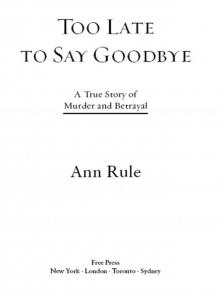 Too Late to Say Goodbye: A True Story of Murder and Betrayal
Too Late to Say Goodbye: A True Story of Murder and Betrayal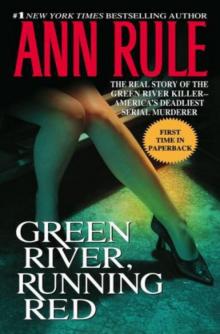 Green River, Running Red
Green River, Running Red Bitter Harvest
Bitter Harvest Dead by Sunset: Perfect Husband, Perfect Killer?
Dead by Sunset: Perfect Husband, Perfect Killer?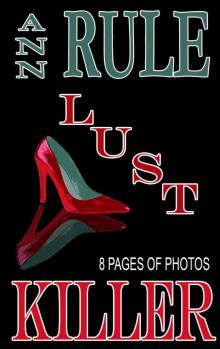 Lust Killer
Lust Killer And Never Let Her Go: Thomas Capano: The Deadly Seducer
And Never Let Her Go: Thomas Capano: The Deadly Seducer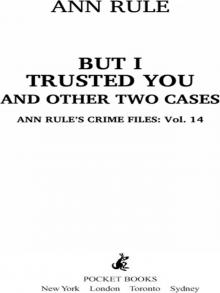 But I Trusted You and Other True Cases
But I Trusted You and Other True Cases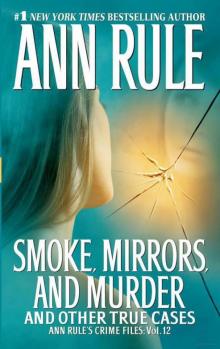 Smoke, Mirrors, and Murder and Other True Cases
Smoke, Mirrors, and Murder and Other True Cases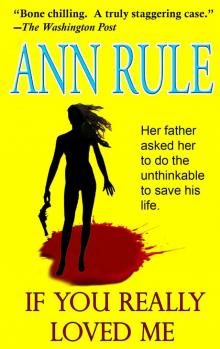 If You Really Loved Me
If You Really Loved Me Kiss Me, Kill Me and Other True Cases
Kiss Me, Kill Me and Other True Cases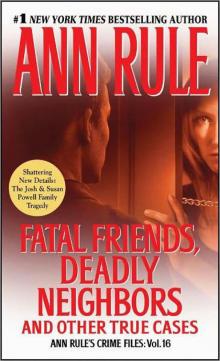 Fatal Friends, Deadly Neighbors and Other True Cases
Fatal Friends, Deadly Neighbors and Other True Cases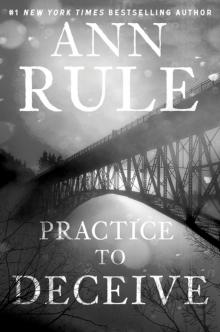 Practice to Deceive
Practice to Deceive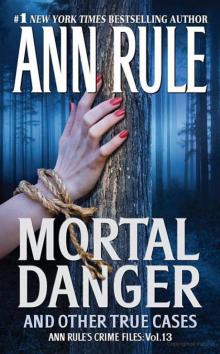 Mortal Danger and Other True Cases
Mortal Danger and Other True Cases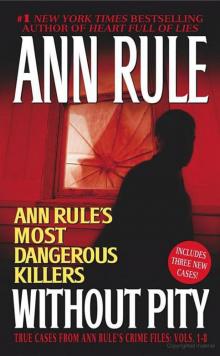 Without Pity: Ann Rule's Most Dangerous Killers
Without Pity: Ann Rule's Most Dangerous Killers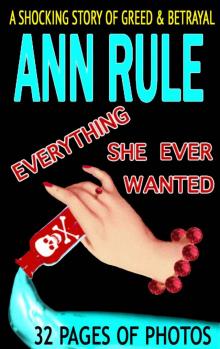 Everything She Ever Wanted
Everything She Ever Wanted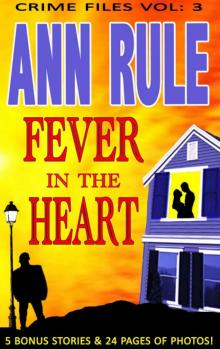 A Fever in the Heart and Other True Cases
A Fever in the Heart and Other True Cases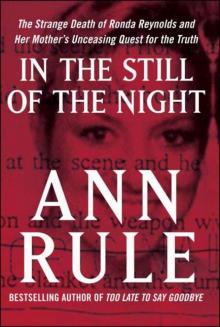 In the Still of the Night
In the Still of the Night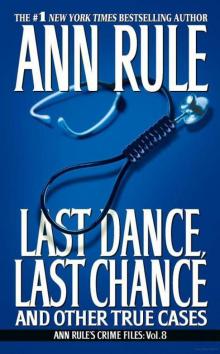 LAST DANCE, LAST CHANCE - and Other True Cases
LAST DANCE, LAST CHANCE - and Other True Cases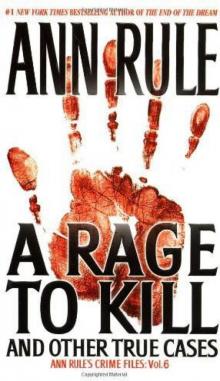 A Rage to Kill
A Rage to Kill The I-5 Killer
The I-5 Killer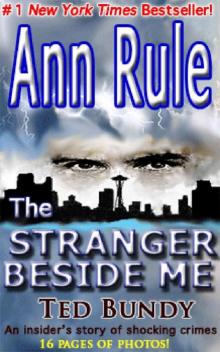 The Stranger Beside Me
The Stranger Beside Me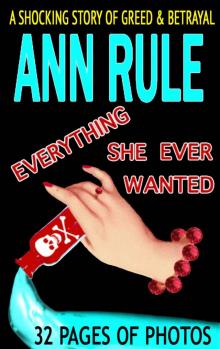 Everything She Ever Wanted: A True Story of Obsessive Love, Murder, and Betrayal
Everything She Ever Wanted: A True Story of Obsessive Love, Murder, and Betrayal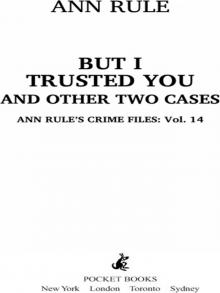 But I Trusted You
But I Trusted You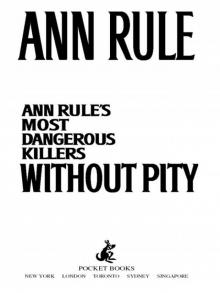 Without Pity
Without Pity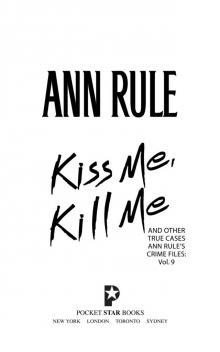 Kiss Me, Kill Me
Kiss Me, Kill Me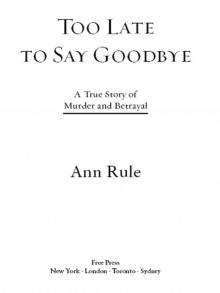 Too Late to Say Goodbye
Too Late to Say Goodbye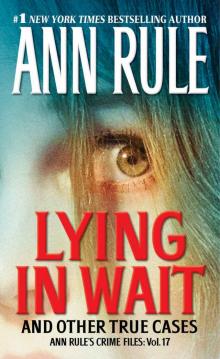 Lying in Wait
Lying in Wait Fatal Friends, Deadly Neighbors
Fatal Friends, Deadly Neighbors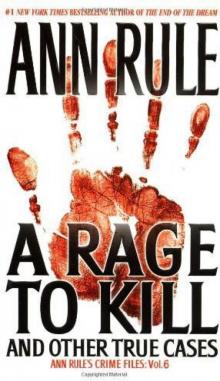 A Rage to Kill: And Other True Cases
A Rage to Kill: And Other True Cases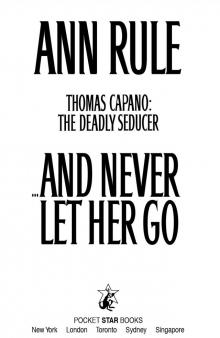 And Never Let Her Go
And Never Let Her Go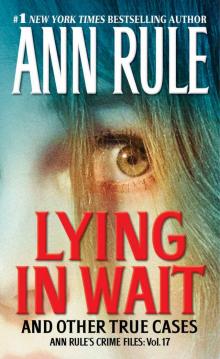 Lying in Wait Ann Rule's Crime Files Vol.17
Lying in Wait Ann Rule's Crime Files Vol.17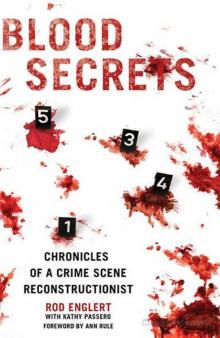 Blood Secrets: Chronicles of a Crime Scene Reconstructionist
Blood Secrets: Chronicles of a Crime Scene Reconstructionist No Regrets
No Regrets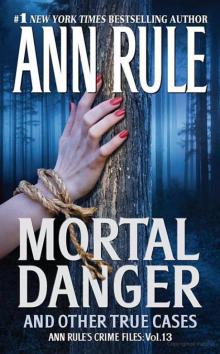 Mortal Danger
Mortal Danger But I Trusted You: Ann Rule's Crime Files #14
But I Trusted You: Ann Rule's Crime Files #14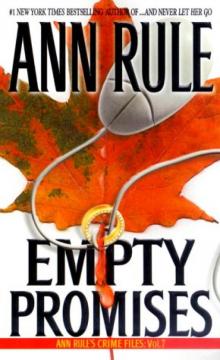 Empty Promises
Empty Promises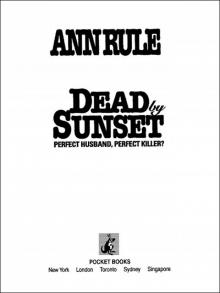 Dead by Sunset
Dead by Sunset Last Dance, Last Chance
Last Dance, Last Chance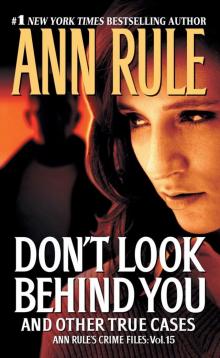 Don't Look Behind You
Don't Look Behind You